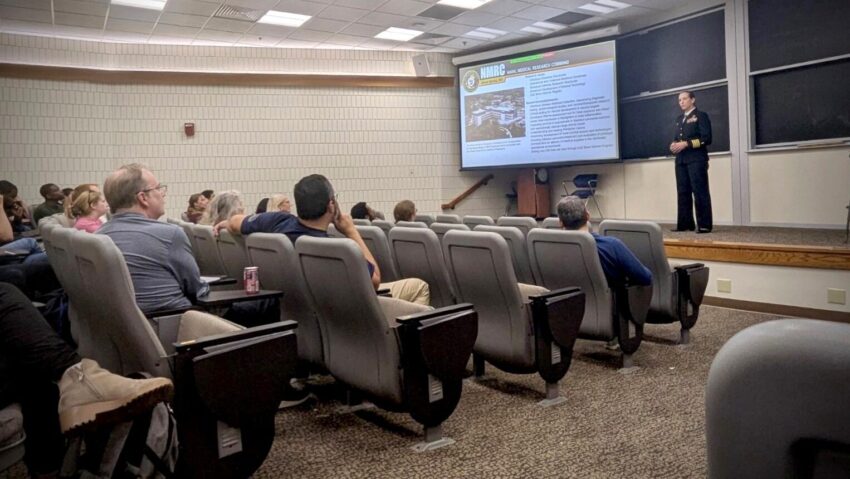Capt. Franca Jones, commander, Naval Medical Research Command (NMRC) presents a brief to scientists and leadership with Notre Dame University. (US Navy Photo by Dr. Jill Phan/Released)
While Beijing continues to surge investment into military modernization and dual-use technologies, a quiet policy shift at the Department of Defense could erode a long-standing US advantage: the university-based defense research infrastructure that fortifies our military edge.
These investments have had a direct benefit to warfighters. Just look in recent weeks, when Iranian missiles were intercepted by air defense systems rooted in decades of university-led research. That success, largely invisible to the public, underscores what’s at stake.
At issue is an announced 15 percent cap on facilities and administrative (F&A) reimbursements for university-based defense research. These reimbursements don’t generate profit, they help cover the cost of operating secure labs, energy-intensive test chambers, cybersecurity infrastructure, and the basic utilities that keep research environments running. Undermining that support weakens the physical and digital foundations of defense innovation, and by extension, the technological advantage of the US warfighter.
Since World War II, America’s collaborative model, bringing together government, industry, and academia, has delivered breakthroughs that define modern security: radar, GPS, jet engines, night vision, autonomous systems, artificial intelligence, quantum computing, and more. Today, nearly half of the Department of Defense’s basic research funding flows to colleges and universities. Limiting support for these institutions risks ceding ground to strategic competitors.
Weakening the federal investments that shore up America’s defense testbeds, labs, and other research facilities creates an opportunity for peer and near-peer competitors to surpass our long-standing military dominance and technological edge. That primarily means China, which is investing heavily in dual-use research infrastructure, recruiting US-trained scientists, buying up intellectual property, and building military-civil fusion centers modeled after the same kinds of partnerships we risk underfunding.
Against this backdrop, the proposed F&A cap is difficult to reconcile with the DoD’s stated broader strategic objectives. Gen. Dan Caine, Chairman of the Joint Chiefs, recently emphasized, “Our systems need to be built for the war of the future, not the war of the past, and this means using technology and innovation at the tactical edge.” That edge begins with the very labs now facing reduced support.
Performing these defense research projects comes with significant but necessary expenses. Securing sensitive materials, protecting and safely storing critical data, harnessing energy-intensive technologies and test chambers, maintaining labs, and preserving mechanical infrastructure all require resources.
Under the current system, higher education institutions pay these costs upfront when they conduct DoD-sponsored research. The government then partially reimburses universities for some of these expenses. Reducing reimbursements for university defense labs risks degrading the physical and cyber infrastructure that gives our warfighters the edge in every domain: land, sea, air, space, and cyber.
Across the country, federal F&A reimbursements help maintain university facilities and related costs that make critical contributions to the United States defense research ecosystem. These innovations include:
Penn State University’s advancements in cold spray technology, using high-velocity metal particles to repair ships without heat, are helping the US Navy eliminate costly unscheduled dry dock repairs — saving taxpayer dollars.
Groundbreaking research at the University of Notre Dame on low-power antennas is opening new possibilities for the Army’s secure communications networks to safeguard America’s number one asset — people.
North Carolina State University’s Commercial Leap Ahead for Wide Bandgap Semiconductors (CLAWS) Hub is developing high-efficiency chips for electronic devices used by DoD and civilian entities, advancements necessary to win the race to Quantum technology.
The University of Florida, via its Florida Applied Research in Engineering (FLARE) program, is operating and maintaining a state-of-the-art research space to support collaborative research efforts with Eglin Air Force Base.
Auburn University’s Applied Research Institute established a radiation hardening test facility for military microelectronics in space environments — both examples accelerating our hold on a contested domain for future conflicts.
These are just a few examples of how our academic institutions serve as critical nodes in the defense research ecosystem. Undermining their capacity is not a budgeting tweak, it’s a step backward in our ability to compete and win.
Here’s the thing: This has proven to be an incredibly efficient investment. In 2023, the average American’s share of federal university defense research spending is about seven cents a day. According to The Science Coalition, academic research supports over 300,000 skilled jobs, drives private-sector innovation, and for every federal dollar invested returns up to $10 in economic impact.
That is not a subsidy; it is a strategy.
At a time when adversaries are increasing commitment, and in some areas surpassing US investments in defense and emerging technologies, we should be strengthening our most effective innovation partnerships, not scaling back. Leadership from within DoD and the broader administration can help ensure that well-intended cost controls don’t inadvertently undermine long-term defense readiness.
The question isn’t whether we can afford to invest in defense research, but whether we can afford the risks of not doing so. Fighting 21st-century threats with 20th-century technology risks surrendering our strategic edge and invites adversaries to bet on American complacency.
Abigail Robbins serves as president of The Science Coalition, a nonprofit and nonpartisan organization comprised of more than 50 leading public and private research universities.
Malcolm Warbrick, Army LTC (ret.), served in the US Army for 27 years and currently sits on The Science Coalition Steering Committee.
Click this link for the original source of this article.
Author: Abigail Robbins and Malcolm Warbrick
This content is courtesy of, and owned and copyrighted by, https://breakingdefense.com and its author. This content is made available by use of the public RSS feed offered by the host site and is used for educational purposes only. If you are the author or represent the host site and would like this content removed now and in the future, please contact USSANews.com using the email address in the Contact page found in the website menu.








